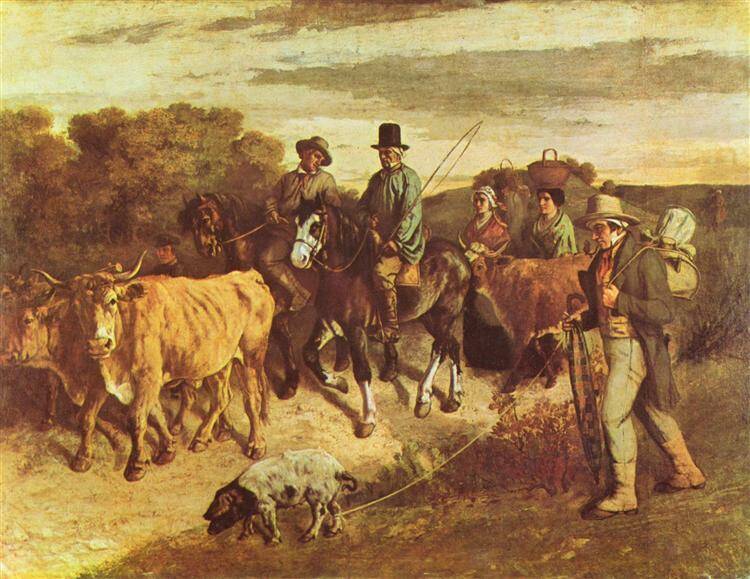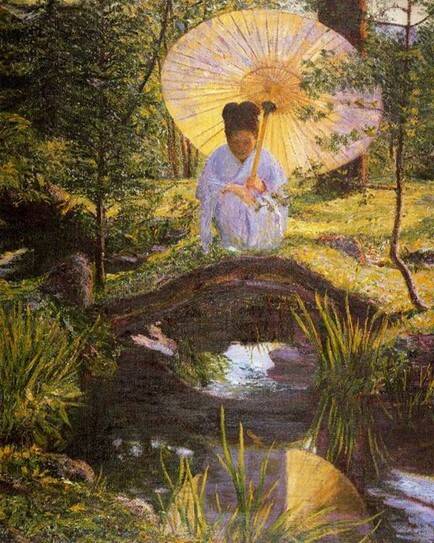- Home
- / Blog
- / Art History
5 Boundaries Broken By Impressionism Light and Shadow
01/25/2021
In impressionism light and shadow play with colors and impact the senses and emotions in boundary breaking, history making, art stories. Impressionism was an artistic movement that studied light, shadow, and their impact on colors.
|
Eugène Boudin, Saint-Valery-sur-Somme 1891, (oil on canvas), 46 × 65.4 cm, Private Collection. Wikimedia Commons |
In many ways it is the art itself that has made this the best known art movement in the world. When you hear the word impressionism you may think of paintings full of light and colors, like Monet’s Nymphea (we call them Water Lillies). Light has shaped and defined impressionism in almost every way. Examining the role of light in impressionism could start with examining five ways in which impressionism broke boundaries, and why light is so important in Impressionism. But first a little history of the era.
impressionism emerged as a counter movement
Impressionism was an art movement that emerged in the mid 19th century in France; in the present day we would call it a protest movement against the status quo "controllers" of the art scene, the Royal Academy and The Salon. Impressionism was mainly a painting movement but it also spread to other forms of art such as photography and movies.
At that time, the display and creation of art was mainly controlled by the Royal Academy of Arts. If you wanted to do an exhibition it had to be accepted by the very exclusive and small jury called “The Salon”. The art movement that was dominant was realism, although neoclassicism was still quite popular as well.
In neoclassicism there were very strict codes regarding the composition and the choice of subject. They usually depicted scenes from the Bible and had moral themes or were representations of mythological allegories and connections to Greek or Roman classicism.
|
Self-portrait Painting David's Belisarius, Public domain, via Wikimedia Commons |
Neoclassical painter Marie-Guillemine Benoist portrayed herself in this self portrait as female artist, classically presenting herself as if a Muse, in true neoclassical form. |
In realism, painters such as Courbet tried to show reality as how it was. These kinds of paintings usually depicted everyday scenes of the life of peasants, which weren’t shown before.
|
Gustave Courbet The Peasants of Flagey Returning from the Fair, 1850-55. via Wiki Art |
On the contrary, Impressionists painted what they saw personally. They weren’t interested in painting what was in front of them exactly. They used reality as a structure and didn’t completely run away from figuration.
In 1874, a group of artists decided to make exhibits on their own, without the approbation of the Salon. They called themselves the Anonymous Society of painters. This group had been repetitively refused by the Salon and wanted to show their work to the world. The group was founded by Monet, Renoir, Degas, Sisley, Bazille, Berthe Morisot. They were the patrons of Impressionism.
|
Berthe Morisot, Le berceau, 1872 (oil on canvas) 56 x 46 cm. Musée d’Orsay, Paris via Panoramadelart |
The group was heterogeneous, but they were all united by a same willingness to study light in a new way. In the french painting Le berceau, a mother looks at her baby tenderly. The ambiance is created by the omnipresence of the very light pink and white that dominates the scene. You can almost hear the silence in the room by looking at this artwork. |
Impressionism was born from this quest of capturing the movements of light and shadow. This new way of studying light affected painting in very important ways. Let’s see in detail in what ways studying light completely changed the world of painting.
1. Light Became a Subject Itself
The name Impressionism initially comes from the word impression. It was used by critics to state that the impressionist’s work looked like unfinished sketches, mere impressions of something and not real artworks.
|
|
Monet reclaimed the word Impressionism and named one of paintings after it: Impression soleil levant. It is now considered as one of the first impressionist paintings. The main subject of this painting isn’t the person rowing on the boat in the first panel. The subject is the lighting of the scene as a whole.
The contrasting colors put an emphasis on the ephemeral nature of the sunrise. Monet’s painting is full of two complementary colors : orange and blue. As the blue is quite grey, the orange stands out even more as a bold color.
2. Paintings Became More Spontaneous
The invention of small metal oil tubes enabled painters to carry their material outside easily. As a result, painters started to paint more outdoors. This method led to the expression “plein air’’ painting ( which means outside) or ‘peinture sur le motif’’ which means painting with the presence of the subject you are painting.
Realist painters would sketch something beforehand and then paint it later in their studio.
|
Auguste Renoir, La grenouillère, 1869 (oil on canvas), 66x81, Nationalmuseum, Stockolm via wikipedia |
With this method, an impressionist could paint everything in one setting. As they wanted to catch the fugacity of the moment, the brushstrokes were less precise. they weren’t blended and concealed, they were left out as it is to be seen.
La grenouillère illustrates well this idea of capturing the movement through spontaneous brushstrokes. You can see how the illusion of movement of water was created by the various horizontal brush strokes.
As light doesn’t have a shape, it can’t have to be captured by a certain form.
Impressionists painted the impermanence of life, and how natural phenomenons would change through time. By painting outside, these impressionist artists would see this change of ambient light and shadow and integrate it in their painting. The impressionist style is rooted in this idea of experiencing natural light and shadow. Indoors the light stays the same and there is not that much variation.
Not all painters impressionists painted outside; Degas only painted inside for example. They were all drawn to the same fugacity of light, wherever it was inside or outside.
3. Colors Became More Vibrant
In impressionism the play of light and shadow enabled the use of more explosive colors. Colours were used more boldly than in realism, where earthy and measured tones usually dominated.
By giving colors to things that weren’t presented that way in reality, they gave a new meaning to color and to reality in a sense. This new study of light affected the use of colors. This change of color was actually a radical act. Many french impressionists were interested in color theory, and it shows in their work. Impressionism was defined by its approach to light and shadow, but also by its use of bright colors.
|
With the invention of new portable tubes came new kinds of pigments. These pigments became more accessible to everyone. Impressionists started to explore stronger hues.
In Dressing dolls, the artist Beaux depicts a child surrounded by vivid floating colors. They are applied in large brush strokes and create an intimate imaginary atmosphere. |
Cecilia Beaux, Dressing dolls, 1928 (oil on canvas) 88,9 x 71,1 cm. Private collection, The Athenaeum |
The impressionist movement encouraged the use of oil paint directly out of the tube. This way they had a pure color. This juxtaposition creates the illusion of different colors from far apart. This technique was then taken to its extreme by the pointillists : they studied color theory in great depths. You will also notice that you will very rarely find black in impressionist style paintings. Shadows were always colorful; not just dark spots.
4. A New Exploration of Space and Perspective Began
Even in realism, painting scenes seemed a bit staged sometimes. Impressionists tried to grasp scenes in the moment, which created scenes with unconventional angles. They were guided by the way the light occupied a place and seized that into their paintings.
By following the ways light appeared, impressionists explored different ways to represent space. The backgrounds became more blurry and interpretative and less realistic of the outside world.
|
Edgar Degas, L'Étoile, 1876 via histoire
|
Impressionists framed elements differently than realism. They focused on details that weren’t presented that way before. The artist Degas is famous for painting dancers from many points of view. He explored the opera universe from an intimate yet not intrusive perspective. |
The way he captured light and shadow in movement was truly unique. His interest for interior spaces was influenced by his eyesight problem.The bright light of the full sun would burn his eyes, therefore had to paint indoors. His artwork l’étoile shows a dancer viewed a bit from above, as in a dream. The light coming from underneath creates a particular atmosphere that you can find in most of Degas’s work.
5. Painters reconnected to nature
As we have seen, some impressionists painted en ‘’plein air’’. This way they were more exposed to natural environments. French impressionists started to develop more sensitivity to nature through the study of natural light. This created a slight change in the choice of subject also. In realism there were already scenes of nature, but they weren’t depicted the same way. The impressionist movement depicted the affective and sensible dimension of nature, not just it’s shapes.
|
Lilla Cabot Perry, In a Japanese Garden, 1901 (oil painting), 78x63 via Wikimedia Commons |
Some painters would paint repetitively the same landscape, but at different times of the day. This way they were able to capture all the potential of the same scenery. Impressionist paintings do not show supremacy over nature but on the contrary their profound admiration.
Lilla Cabot Perry was a student of Monet’s and was also influenced by Japan and it’s zen buddhist philosophy. She was part of the american impressionism movement, along Mary Cassatt.
In a Japanese Garden shows a woman bathing and watching the stream go by. This painting isn’t about the woman, but about the relationship between humans and nature. The artist used the metaphor of water to illustrate the expanding nature of time. This idea of the importance of contemplation of nature is deeply rooted in eastern philosophy.
Lighting the Way to Post-Impressionism
As we’ve seen, impressionists were a heterogenous group. The group divided itself quickly into different forms of post-impressionism art. The main figures of this movement were Gauguin, Cezanne, Van Gogh, Signac, Seurat. There are many subcategories in post-impressionism: pointillism, neo-impressionism, expressionism, fauvism, cubism…
Post-impressionists studied light in a less naturalistic way than impressionism. They worked on the distortion of shapes and an even more vibrant explosion of colors. In Cezanne’s painting Les grandes baigneuses, there is an interesting cloudy brushwork. The faces are indistinguishable as they aren’t real life portraits. These figures were very important to the painter as he painted this same for more than ten years. They represented something else for him; they became personal symbols.
 |
Paul Cézanne, Public domain, via Wikimedia Commons
Even though these postmodernists painters were still figurative, they took great liberty in the representation of humans through their palettes and expressive strokes. They deconstructed in many ways how subjects were represented. Post impressionism ventured far in the exploration of subjectivity: a boundary that impressionism had only started to push against.
__________________________________________________________________________________________________________________________
Sophia Savagner is a franco-americano visual artist living in Athens. She studied psychology in France and then started freelancing as a writer. She enjoys wandering in nature and discovering new horizons. She explores the human mind through art and meditation.
Social links : https://www.instagram.com/sophiasavagner/
https://www.sophiasavagner.com/





 Claude Monet, Impression soleil levant, 1872 (oil on canvas), 48x63 cm via
Claude Monet, Impression soleil levant, 1872 (oil on canvas), 48x63 cm via 




